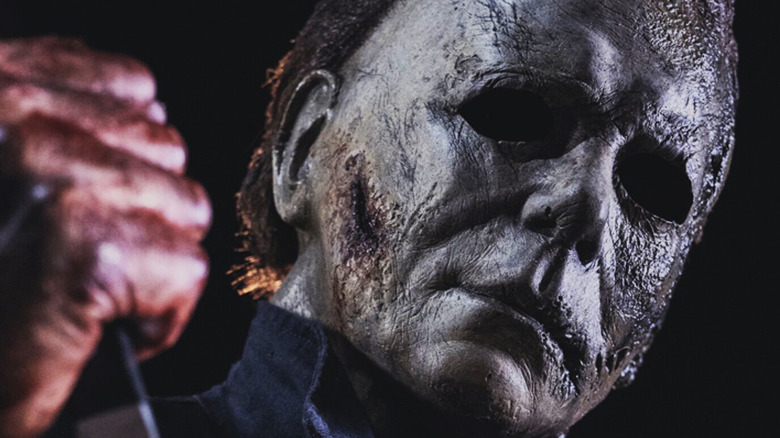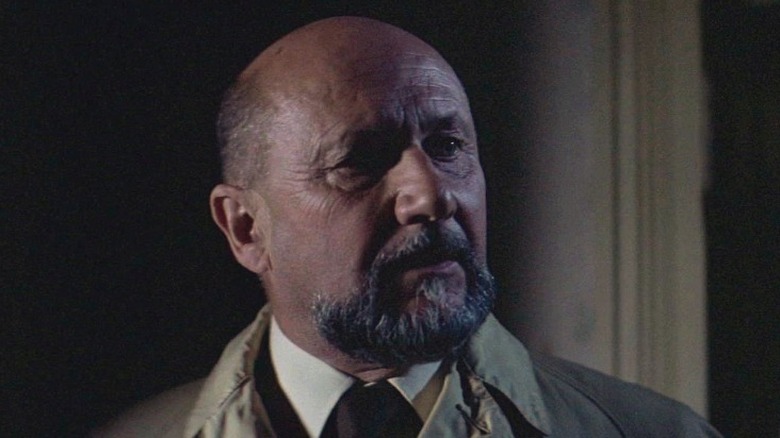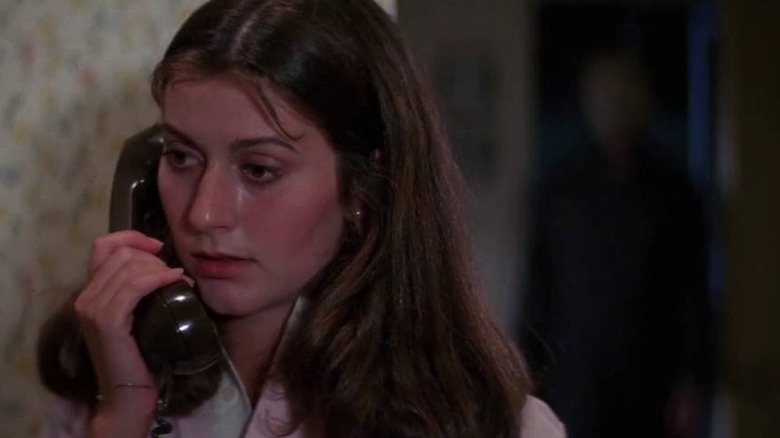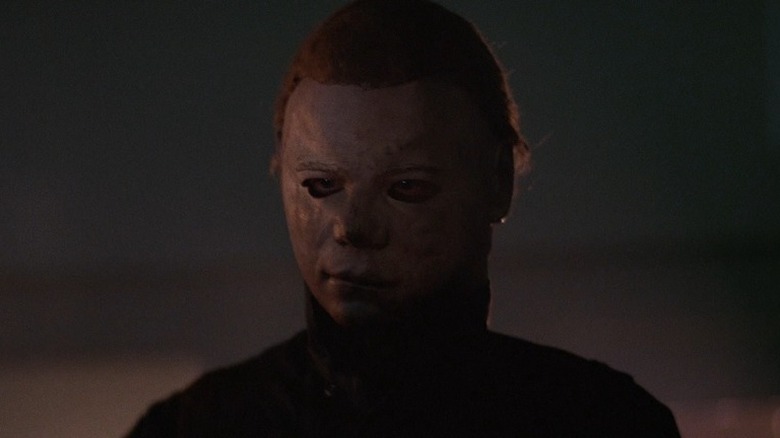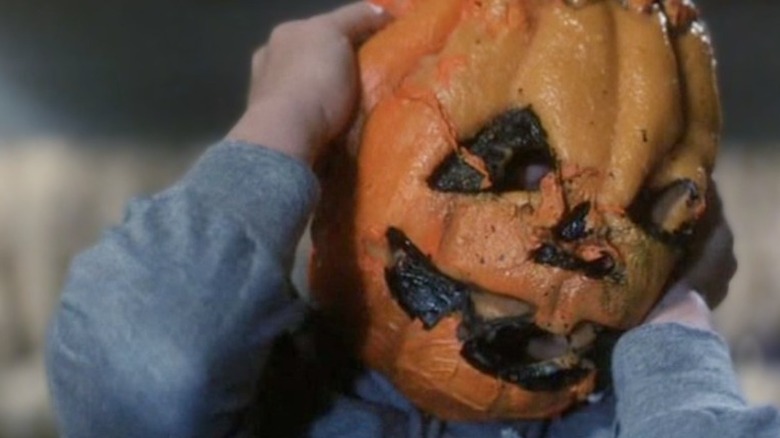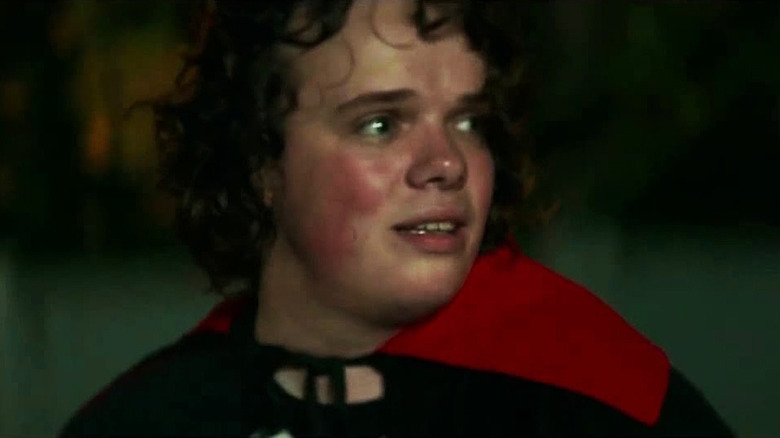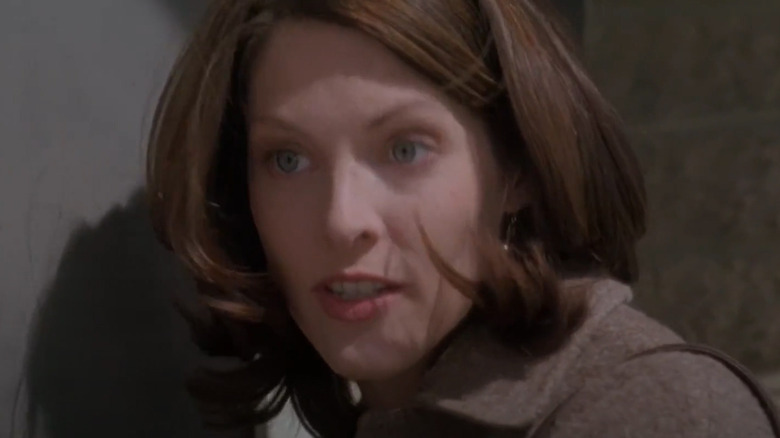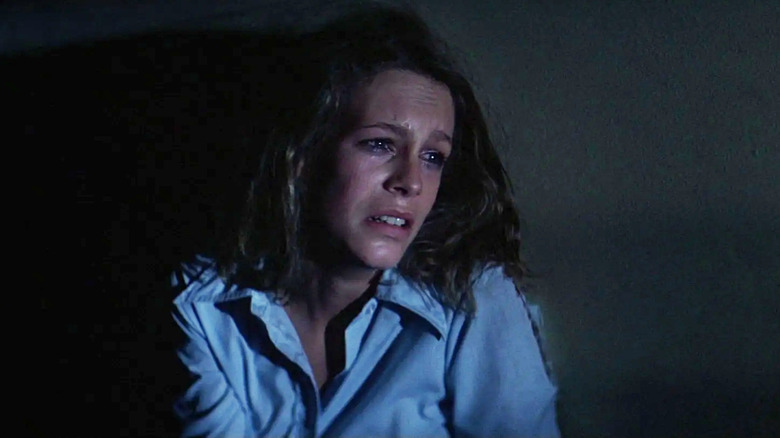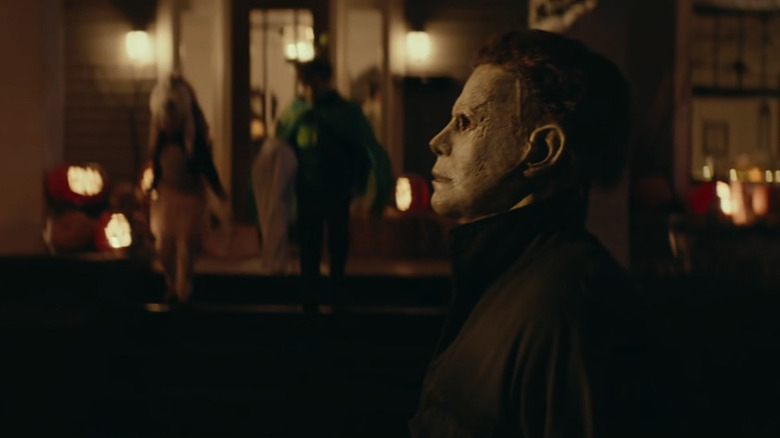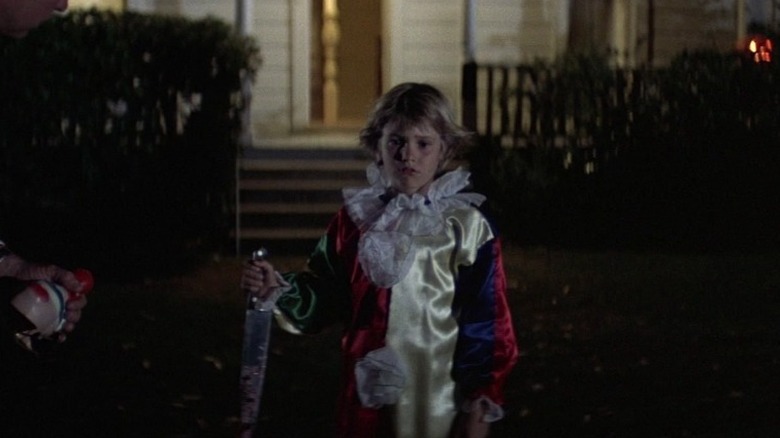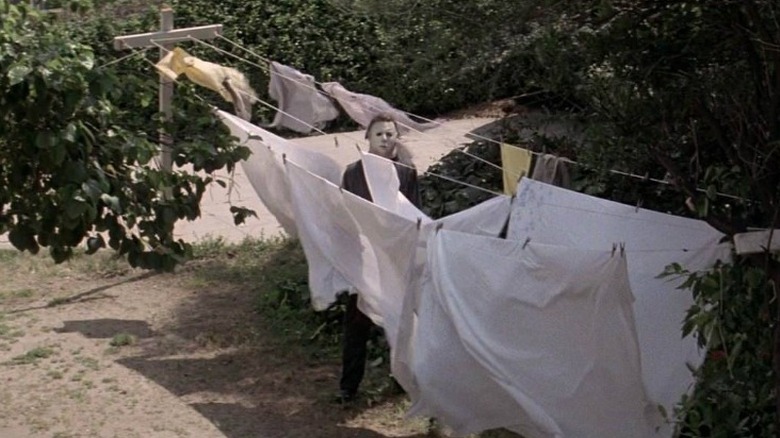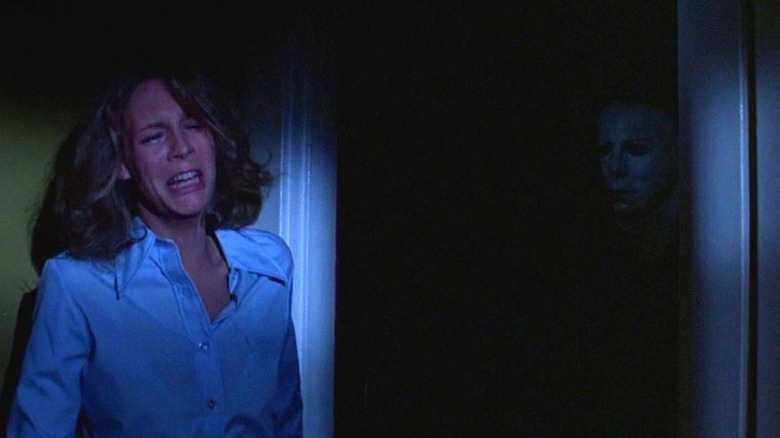The 11 Scariest Scenes In The Halloween Franchise
Is there any other horror franchise with a continuity as convoluted as that of the Halloween films? The Halloween timeline has been reset, rebooted, and retconned more than any other series (apart from maybe the X-Men franchise) and it makes watching all the films a much harder task than you might think for what is, essentially, a B-movie slasher series.
Michael Myers is one of the most iconic and simultaneously mysterious villains of horror cinema. While Freddy Krueger and Jason Voorhees became more knowable, even likeable, in their numerous sequels (Freddy in particular took on antihero status as his films went on, complete with jokey one-liners) Michael remains a blank slate for the entirety of his series. Later installments attempted to imbue him with supernatural powers, and Rob Zombie's reboot tried to give him an origin story, but Michael is at his most effective as an unknowable figure. Much like the Xenomorph from "Alien," he's an effective villain precisely because we don't know what makes him tick.
With the latest entry in the series, "Halloween Kills", set for a release later this year, we've ranked the 11 scariest moments from across the franchise that gave birth to the slasher movie genre. These aren't necessarily the goriest moments (sorry, Rob Zombie) as much as the scenes that sent shivers up our spines. With that in mind, here we go:
Halloween — Loomis' speech
If there's one actor associated with the Halloween franchise whose name isn't Jamie Lee Curtis, it's Donald Pleasence. Over the years, Pleasance has been refreshingly candid about his experience shooting the movie, claiming to not understand certain aspects of the film. Still, he clearly enjoyed something about his role as Dr. Sam Loomis, as he returned for four of the sequels. He is at his best in the first film, and this speech, in which he describes Michael, is one of the most memorable moments in horror cinema.
"I met this six-year-old child with this blank, pale, emotionless face, and the blackest eyes, the Devil's eyes," Loomis says. "I spent eight years trying to reach him, and then another seven trying to keep him locked up, because I realized that what was living behind that boy's eyes was purely and simply evil."
It's a genuinely atmospheric, ominous speech, and proves the importance of dialogue and performance, even in a slasher movie. It's almost as memorable as the Indianapolis speech from "Jaws", and Pleasence's matter-of-fact, stoic delivery is perfect for the character. In later films, Loomis was reduced to a mad scientist stereotype, with Pleasence either phoning in his performances or going wildly over the top. Here, though, he completely nails his character's regret at having failed his patient, and his grim determination to lock Michael away forever.
Halloween 2 — Visiting the neighbors
The only sequel of the original run that feels cut from the same cloth as the first film, "Halloween 2" is nevertheless a strange film. After director Rick Rosenthal finished filming, John Carpenter decided it wasn't scary enough and shot extra scenes to bump up the body count. This re-edited version is gorier and more atmospheric than the theatrical release, delighting in the gruesome deaths of Michael's victims (the hot tub murder is particularly nasty) but it's rarely genuinely frightening.
One exception is a scene that was added by Carpenter, which is memorable for its execution more than the kill itself. Set mere moments after the conclusion of the first film, we see Alice (Anne Bruner) on the phone to her friend while Michael silently walks into the room behind her. The sound design should feel cluttered and distracting here, with the voice on the phone and the news bulletin on the radio, but it actually adds to the suspense — the various elements build until Alice realizes just how close she was to the murders from the first film, and that there is a killer on the loose in her immediate vicinity.
As an audience member, you know where Michael is, but the scene still manages to surprise you when he attacks, leading to a genuine jump scare. We also catch a glimpse of Michael's eyes here, and they are just as menacing as you'd hope, staring intently at Alice as he stabs her.
Halloween 2 — Michael's mask
The mask that Michael picks for himself in "Halloween" is perfect for his character: cold, pale, and unsmiling, with dark pools for eyes. It embodies the mythic nature of Michael as the boogieman, and makes him appear inhuman. This mask may as well be his real face.
However, the design and quality of the mask changes dramatically from film to film, reaching its lowest point in "Halloween H20,” in which the filmmakers briefly resorted to an appalling CGI mask. However, in "Halloween 2," the mask looks arguably even more disturbing than it did in the original film. It's the exact same mask, but it looks weathered and dirty. More interestingly, it doesn't fit the new actor playing Michael as well as it did the original actor. It's stretched, allowing you to see Michael's eyes briefly, which might sound a bit demystifying but ends up being pretty unsettling; for once you get the impression that there's a real person under the mask, albeit one who's a monster.
The mask even looks terrifying in the bright neon lights of the hospital, and that's not even mentioning the moment when blood pours out of the eye holes as Michael continues to pursue Laurie (Jamie Lee Curtis). The original mask is iconic, but the "Halloween 2" iteration is the stuff of nightmares.
Halloween 3: Season of the Witch — The pumpkin mask
"Halloween 3: Season of the Witch" is the black sheep of the Halloween films. Before the character of Michael Myers captured the imagination of audiences, Carpenter and producer Debra Hill originally envisaged the films as a series of standalone horror films, along the lines of "The Twilight Zone" and "The Outer Limits."
This one diversion from the Myers story is a weird but fun outing into supernatural hijinks, as an evil corporation-slash-cult creates and distributes deadly Halloween masks imbued with ancient malicious magic as part of a pagan ritual. It all sounds pretty silly, until we reach the scene in which the company tests their plan out on an unassuming family. The results are macabre and terrifying. Young Buddy Kupfer is killed by his mask, his head crushed and consumed by various creatures: insects, snakes and rats.
It's a truly horrifying sequence, reminiscent of George A Romero's "Creepshow," especially with Buddy's one visible eye staring unblinking into the camera. It's also a bold statement of intent: Michael may return in the next film, but from this point forward, no one in the series is safe, not even children.
Halloween (2018) — The motion sensor scene
The latest reboot of the Halloween series is the strongest since the original film, getting rid of the contrived supernatural elements, stripping the story back down to the core elements of Carpenter's first entry, and bringing back both Laurie Strode and a score co-written by Carpenter. Most importantly, however, it brings Michael down to Earth.
In a nice nod to the way technology has advanced since 1978, Michael encounters Oscar (Drew Scheid) in a backyard, only to be confronted with a motion sensor light. At first mistaking Michael for the homeowner, Oscar starts chatting, allowing the killer to get closer as the light blinks on and off. Michael is known for his unnatural stillness, so it feels oddly appropriate that his movements are unseen in the dark. It's a neat and original conceit, and the geography of the backyard, along with the disorienting, shifting camera angles, mean that we're never sure how much ground Michael covers before the light comes back on. It's a short sequence, but one that sends chills down the spine and feels very on-brand for the character.
This scene is also notable for the awesome chord on the soundtrack, which plays as Michael finally reveals himself to Alyson (Andi Matichak), Laurie's granddaughter. It's a jarring and fittingly bombastic moment as the two characters set eyes on each other for the first time, achieved by running a bow across an electric guitar. Michael Myers is back.
Halloween H20 — The bathroom scene
The first movie in the series to be written after the runaway success of "Scream," "Halloween H20" often feels like it's riding on the success of Wes Craven's film. However, it's legitimately scary in places, and unlike most films in the franchise exercises restraint in a way that serves to heighten the tension.
Most memorable is this scene, which features two characters who don't appear in the rest of the film. A mother and daughter visit a rest stop on a long car journey, only for an unseen hand to appear under the mother's stall and grab her handbag. Proving that you don't need gore or violence to generate fear, this sequence is all about the building suspense. Nobody dies, but it nonetheless manages to be incredibly creepy. The contrast of the little girl singing to herself while the mother fearfully glances through the crack in the door, catching the briefest glimpse of Michael's blank mask, is a nightmare come to life. The brief moment when the two make eye contact is chilling.
This is all we see of Michael in this sequence, too. Everything else is left to our imagination, as the mother listens intently for her daughter, hoping the girl will keep quiet. It's an almost unbearably tense scene, and one that anyone who has been alone in a similar situation can relate to.
Halloween — Where is the Boogieman?
John Carpenter's original film might be the quintessential slasher film. Obviously, imitators arrived almost immediately after its release, but really there was no need for anyone to make more slasher films after this. As referenced by the children in the film, Michael Myers is the definitive "boogieman," a title cemented by the final few minutes of "Halloween."
Having shot Michael Myers off the balcony and seeing him lie prone on the front lawn, Loomis is shocked when he looks back to see that the body has vanished. Laurie lets out a pained cry as she realizes that her ordeal isn't over. What follows could well be a mission statement for every slasher film. We hear Michael's raspy breath grow louder and louder as Carpenter shows us all the shadowy places where Michael could be hiding, both inside the house and out.
In the closing moments, Michael is no longer just a serial killer. He becomes a manifestation of fear itself, and the embodiment of everything you're afraid of in the dark. It's the perfect way to end the film, playing on a primal and all-too-relatable fear of what might be lurking in the shadows, leaving the audience checking behind every curtain before turning the lights out.
Halloween (2018) — The long single take
The most interesting of all the "Halloween" remakes and sequels, David Gordon Green's 2018 iteration pays tribute to the series in a number of ways, never more overtly than in this sequence, set on Halloween night. In a direct homage to the long opening take from the very first film, we see Michael casually walking into people's homes, killing them, and leaving without breaking a stride, all in a single tracking shot. Initially picking up a hammer, before discarding it in favor of a butcher's knife (which he takes from the unfortunate Mrs. Elrod from "Halloween 2"), Michael moves purposefully but attacks at random. Presumably, some people draw his attention more than others, but no reasons are given as to what those are. Mercifully, Michael decides against killing a baby, but it's disturbing enough that he even considers it.
In the nastiest moment, we see Michael's blank mask reflected in a window as he peers inside, only to disappear from view as the occupant lowers the blinds. Then, Michael appears behind her and murders her quickly and brutally. It's not only technically innovative (outdoing Carpenter's work on the original), but it also puts you in Michael's mindset, something the Halloween films don't tend to do. He's also terrifyingly nonchalant about the whole thing. Michael isn't out for revenge, and he's not after anyone in particular. He just wants to kill.
Halloween — Michael's first murder
And yes, here's the original! The first shot of "Halloween" is much imitated but never bettered, and contains one of the most shocking reveals in horror history. In a prolonged single shot, we watch from the point of view of an unseen killer as he stalks and murders his victim. Then, his mask is removed. Underneath is a 6-year-old boy with a blank expression on his face.
This is how Carpenter introduces us to Michael Myers, and it's all the backstory we need. There is some beautiful filmmaking in the original film that elevates it above standard slasher fare, and this virtuoso sequence is independent filmmaking at the highest level. Carpenter pays homage to Hitchcock throughout "Halloween" by reusing character names and casting Curtis ("Psycho" star Janet Leigh's daughter) in the lead role, but arguably the biggest tribute is the use of voyeuristic shots like this.
It's a chilling way to kick off the franchise, and iconic enough to be revisited in "Halloween IV", an otherwise lackluster installment that shifts the focus onto Michael's niece Jamie (Danielle Harris). In the final moments of the movie, we get a point-of-view shot that follows Jamie's stepmother. Hearing screams, Loomis runs upstairs to find Jamie holding a bloody knife, in an almost identical costume to the one Michael wore. It's a harrowing moment, made even better by Pleasence's hysterical breakdown. It's a shame this development was abandoned in the subsequent sequels, as it could have revitalized the series. Alas, it wasn't to be; the next halfway decent Halloween film wouldn't appear for another 10 years.
Halloween — Michael Myers stalks his victims
Again, not all scary scenes need gore or murder. This selection is a bit of a cheat as it's not one specific scene, but the way that Michael stalks his potential victims in the first "Halloween" is just too creepy to be ignored. Laurie first sees Michael standing motionless outside her school, just watching. Later he blocks her and her friends' path on their way home. Most memorably, though, is when he watches Laurie among her sheets before disappearing. It's the fact he's so still, then gone in the blink of an eye, coupled with his mask that makes this moment so unnerving. Moments like these recall the horror of author M. R, James, most notably the stories "Oh, Whistle, and I'll Come to You, My Lad" and "A Warning to the Curious," and undoubtedly served as an influence on the more modern fare like "It Follows".
There's something distinctly alien and even childlike about Michael, especially in the first film. He seems genuinely intrigued by normal people, but doesn't know how to interact with them. So, these moments feel like Michael is trying to observe people as much as terrorize them. The same goes for his eerie head tilt after he pins a victim to the wall with his knife. He regards his victims with curiosity, and that makes him more than just a mindless killing machine, as well as a unique movie monster.
Halloween — The finale
It might sound like an obvious choice, but the ending of "Halloween" is one of the most nerve-wracking finales in horror film history. As Laurie tries to locate her friend Annie, she finds her body lying on the bed with Judith Myers' headstone above her. As Laurie begins to panic, Michael's other victims fall out of various hiding places, leaving her a nervous wreck until his white, impassive face emerges from the shadows behind her.
If there's one image that truly sums up the Halloween franchise it would be this one: Michael's pale, emotionless features emerging from the darkness. It's a truly suspenseful sequence, made even better by Curtis' authentically hysterical performance. She's not a badass. She is completely and utterly traumatized by the ordeal, as anyone would be. The subsequent chase formed the template for every "last girl" slasher movie that was made in the years to come, right down to the final fake-out, a trope that would be referenced and reused to the point of parody.
What makes this scene so unique, though, is the sadistic way that Michael toys with Laurie before attacking. It's not enough to kill her. He wants Laurie completely terrified. As before, this shows that Michael Myers is not a mindless killer, setting him apart from the standard slasher villain.
